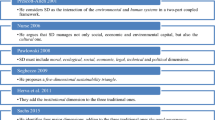Abstract
The objective of this article is the introduction of social time as a new concept for monitoring the progress towards the United Nations’ sustainable development goals (SDGs). Social time is generally measured with social clocks. They compare the socio-economic situation of a nation or another social actor with a real or virtual reference group and determine this way the actor’s temporal lead or lag as compared to this group. Due to the multitude of possible comparisons, social time can be multidimensional, discontinuous, and even reversible. After a general discussion of these properties, the concept is applied to the monitoring of the progress towards a predefined policy goal. In this special situation the reference group is represented by an ideal virtual actor, moving from a starting point to the mentioned policy goal. Finally, for illustrative purposes the article explores with the instruments of social clocks the progress of three Latin American countries (Ecuador, Peru, Paraguay) with regard to poverty, sanitation, and food security. It turns out, that all three countries were in 2020 behind the schedule set by SDGs of the United Nations.







Similar content being viewed by others
Notes
This article uses the term progress in a purely technical way as a movement towards a goal that has a-priori no positive developmentalist connotation.
OECD (2019) uses for the measurement of progress the z-standardized distance of a country from the target-value of the corresponding policy goal (SDG).
A monotonically increasing (or decreasing) reference line is represented by a function f(X) with a slope df/dX that is for all possible X strictly positive (or negative).
A J-curve is represented by a function f(X) with a slope df/dX that increases with the value of X. Consequently, it looks like a letter J, which has given the curve its name.
Data source: World Bank (2023), series SI.POV.NAHC.
Data source: World Bank (2023), series SH.STA.SMSS.ZS.
Data source: World Bank (2023), series SN.ITK.MSFI.ZS.
A delay of 15 to 17 years in 2020 + 10 years between 2020 and 2030 = 25 to 27 years away from the goal.
References
Allan, P. (1987). Social time. In C. Cioffi-Revilla, et al. (Eds.), Communication and interaction in global politics, Chap. 5. Sage.
Bantekas, I., & F. Seatzu (Eds.). (2023). The UN sustainable development goals. Oxford University Press.
Benton-Short, L. (2023). Sustainability and sustainable development. Rowman & Littlefield.
Cherkaoui, M. (2002). Relative deprivation. The International Encyclopedia of Social and Behavioral Sciences, 3522 ff. Elsevier.
Davino, C., et al. (2014). Quantile regression: Theory and applications. Wiley.
Koenker, R. (2018). Computational methods for quantile regression. In R. Koenker at al. (Eds.), Handbook of quantile regression, Chap. 5. CRC Press.
Mueller, G. P. (2005). Divergence and synchronization of the institutional clocks of the welfare state. International journal of comparative sociology, 46, 487–506.
Mueller, G. P. (2018). Time intervals versus composite index scores: An alternative approach for the measurement of the socio-economic development of countries. Social Indicators Research, 136, 1251–1268.
OECD. (2019). Measuring distance to the SDG targets 2019. OECD Publishing.
Rosa, H. (2013). Social acceleration. Columbia University.
Rosa, H. (2017). De-synchronization, dynamic stabilization, dispositional squeeze: The problem of temporal mismatch. In J. Wajcman, & N. Dodd (Eds.), The sociology of speed, chap. 2. Oxford University Press.
Rummel, R. (1972). Social time and international relations. General Systems, 17, 145–158.
Runciman, W. G. (1972). Relative deprivation and social justice. Penguin Books.
Sablier, A. (1997). Une nouvelle approche des phénomènes sociaux: Les horloges sociales. (A new approach to social phenomena: Social clocks). L’Harmattan.
Sicherl, P. (1973). Time distance as a dynamic measure of disparities in social and economic development. Kyklos, 26(3), 559–575.
Sicherl, P. (2011a). Time distance in economics and statistics. Edition Echoraum.
Sicherl, P. (2011b). New understanding and insights from time-series data, based on two generic measures: S-time-distance and S-time-step. OECD Statistics Working Papers 2011/09 Paris: OECD Publications.
United Nations. (2023). The 17 Goals. Retrieved, April 5, 2023, from https://sdgs.un.org/goals
World Bank. (2023). Data Bank: Sustainable Development Goals. Retrieved, April 2, 2023, from https://databank.worldbank.org/source/sustainable-development-goals-(sdgs)/
Author information
Authors and Affiliations
Corresponding author
Ethics declarations
Conflict of interest
There are no conflicts of interest of any kind.
The article is the author’s own work and free of (auto-) plagiarism.
Due to the high aggregation of data there are no problems with informed consent.
Additional information
Publisher’s Note
Springer Nature remains neutral with regard to jurisdictional claims in published maps and institutional affiliations.
Electronic Supplementary Material
Below is the link to the electronic supplementary material.
Glossary
- Lagx
-
Lag of an actor regarding the development variable X and compared to its reference trajectory
- Lagt
-
Temporal lag of an actor, analogous to Lagx
- Leadx
-
Lead of an actor regarding the development variable X and compared to its reference trajectory
- Leadt
-
Temporal lead of an actor, analogous to Leadx
- t
-
Physical time
- T
-
Social time
- tend
-
Temporal end of a process
- tstart start
-
Temporal start of a process
- X
-
Development variable
Rights and permissions
Springer Nature or its licensor (e.g. a society or other partner) holds exclusive rights to this article under a publishing agreement with the author(s) or other rightsholder(s); author self-archiving of the accepted manuscript version of this article is solely governed by the terms of such publishing agreement and applicable law.
About this article
Cite this article
Mueller, G.P. Social clocks as instruments for measuring progress towards sustainable development goals. Environ Dev Sustain (2024). https://doi.org/10.1007/s10668-024-04858-1
Received:
Accepted:
Published:
DOI: https://doi.org/10.1007/s10668-024-04858-1




